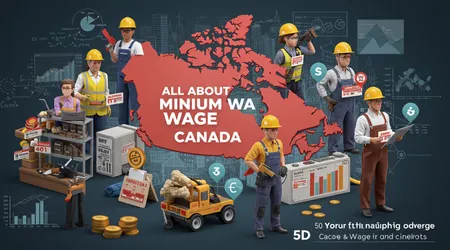Minimum Wage in Canada in 2025: What Has Changed?

Minimum wage in Canada in 2025 shapes livelihoods and economic debates.
This year’s adjustments ripple through wallets, businesses, and policy discussions. From federal hikes to provincial shifts, these changes spark hope for workers and challenges for employers.
Let’s unpack what’s new, why it matters, and how it affects Canadians.
Rising costs define life today. Groceries, rent, and gas gnaw at budgets. For low-income earners, every cent counts.
The federal government and provinces have responded, tweaking wages to ease the squeeze. But do these changes go far enough?
Are they sustainable for businesses?
This article dives deep, offering clarity on a topic that touches millions.
We’ll explore federal and provincial updates, economic impacts, and real-world stories. Expect practical insights, not just numbers.
Whether you’re a worker, employer, or curious reader, this guide cuts through the noise. Let’s navigate the stakes together, with sharp arguments and fresh perspectives.
Federal Minimum Wage: A Step Forward?
The federal minimum wage in Canada in 2025 climbed to $17.75 per hour on April 1. This 2.4% increase, tied to inflation, targets workers in federally regulated sectors like banking and transportation.
Roughly 26,000 employees benefit, from postal clerks to telecom staff.
This hike aims to match rising costs. Inflation, though cooling, still bites. A loaf of bread costs more than last year. For workers, an extra 45 cents per hour adds up barely.
Full-time, it’s about $936 yearly before taxes. Helpful, but no game-changer.
Yet, employers face pressure. Small firms in regulated industries, like regional transport, juggle tight margins.
Higher wages could mean fewer hires or price increases. Balance is tricky support workers without crippling businesses.
++ What’s happening in Canada today? Top news and updates
Consider Maya, a bank teller in Winnipeg. Her raise helps with groceries, but rent still stings.
Her employer, meanwhile, trims training budgets to cope. Both feel the pinch differently.
The federal move sets a tone. Provinces watch closely, but not all follow suit.
This patchwork approach creates uneven realities across Canada. Let’s dig into that next.

Economic Ripples: Who Wins, Who Loses?
Adjusting minimum wage in Canada in 2025 stirs the economic pot.
Higher wages boost spending. Workers like Sarah, a Vancouver server, buy more clothes or dine out. Retail thrives short-term.
But there’s a catch. Businesses face higher costs. Small restaurants, already hit by inflation, might cut hours.
In Ontario, a 2024 study by the Canadian Federation of Independent Business noted 60% of small firms raised prices after wage hikes.
Also read: The Best Government Benefits Available to Canadians in 2025
Consumers feel it too. A $5 latte becomes $5.50. Families tighten budgets elsewhere.
Inflation, though stable at 2%, could creep up if costs cascade. Economists watch closely.
Job markets shift subtly. Higher wages attract workers but may deter hiring. In B.C., retail jobs stay open longer. Employers seek skilled staff to justify costs, sidelining youth.
Long-term, it’s a gamble. Boosting wages fights poverty but risks layoffs.
Policymakers tread a fine line. Workers gain, businesses strain, and prices creep. Balance is elusive.
Consider rural grocers in Saskatchewan. Higher wages mean leaner staff schedules. Shoppers pay more for milk. Everyone adjusts, but resentment simmers.
Economic harmony? Not quite.
Worker Perspectives: Relief or Mirage?
For workers, minimum wage in Canada in 2025 brings mixed feelings. A few extra dollars help, but soaring rents gobble gains.
In Toronto, a one-bedroom averages $2,500 monthly. Do the math.
Take Ali, a Calgary retail worker. Alberta’s $15.00 feels frozen. He skips meals to save. Ontario’s $17.60 would be a lifeline, but he’s stuck. Geography dictates his struggle.
Young workers, especially students, feel trapped. B.C.’s $17.85 helps part-timers like Priya, a Victoria barista.
Yet, tuition and textbooks outpace her raise. Debt looms large.
Read more: How to Apply for Unemployment Benefits in Canada
Older workers, like Maria in Halifax, see modest relief. Nova Scotia’s $16.50 (October) buys extra groceries. But medical costs linger. Incremental raises don’t solve systemic gaps.
Advocates push for living wages $26 in Toronto, per the Ontario Living Wage Network. Current rates fall short. Workers rally, but governments hesitate. Change feels distant.
Immigrant workers, vital to retail and hospitality, face unique hurdles.
Language barriers limit job options. Wage hikes help, but systemic barriers like credential recognition persist.
Business Challenges: Adapting to New Costs
Higher minimum wage in Canada in 2025 tests businesses. Restaurants, retail, and small firms feel the squeeze most. Payrolls swell, forcing tough choices.
In Ontario, a café owner, Lena, hikes menu prices. Customers grumble but pay. She avoids layoffs, but part-time shifts shrink. Workers lose hours.
Automation creeps in. Fast-food chains in B.C. install kiosks.
Fewer cashiers needed. Technology saves money but cuts entry-level jobs. Youth employment dips.
Larger firms absorb costs better. Banks or telecoms, federally regulated, pass expenses to consumers. Smaller players, like Manitoba’s corner stores, can’t. Some close.
Training budgets shrink too. Employers like Raj, a Montreal retailer, skip staff development.
Productivity stalls, hurting long-term growth. It’s a vicious cycle.
Yet, some adapt creatively. A Halifax bakery offers loyalty discounts to offset price hikes. Sales hold steady, but margins thin. Resilience defines survival.
Businesses lobby for tax breaks to cope. Governments listen but move slowly. Meanwhile, owners innovate or risk folding. The stakes couldn’t be higher.
Provincial Variations: A Mixed Bag
Provincial minimum wage in Canada in 2025 varies widely, reflecting local economies. Ontario’s rate hits $17.60 in October, up 40 cents.
Nunavut leads at $19.00, while Alberta lags at $15.00. Here’s a snapshot:
| Province/Territory | Minimum Wage (2025) | Effective Date |
|---|---|---|
| Ontario | $17.60 | Oct 1 |
| British Columbia | $17.85 | Jun 1 |
| Nunavut | $19.00 | Jan 1 |
| Alberta | $15.00 | No change |
| Quebec | $16.10 | May 1 |
These differences shape lives. In Toronto, $17.60 buys less than in rural Manitoba. Urban workers like baristas or retail staff struggle most. Rural areas, with lower costs, feel less strain.
Take Quebec’s $16.10. It’s modest, but Montreal’s rent spikes outpace it. Workers like Jean, a cashier, cut back on basics.
Meanwhile, Alberta’s stagnant wage frustrates advocates. No raise since 2019? Tough sell.
Businesses adapt unevenly. Ontario cafes might hike coffee prices.
In Nunavut, high wages strain retailers but attract workers. Local policies drive these gaps, sparking debates on fairness.
Equity is the core issue. Why should a cleaner in Alberta earn less than one in B.C.? Provinces argue local conditions justify it. Critics say it deepens inequality.
Policy Debates: Fairness vs. Feasibility
The minimum wage in Canada in 2025 fuels fiery policy clashes. Advocates demand living wages. Businesses plead for restraint. Governments juggle both.
Living wage campaigns gain traction. In Toronto, $26 per hour is the ask. Current rates $17.60 seem paltry. Workers rally, citing rent and childcare costs.
Economists warn of trade-offs. Rapid hikes could spike unemployment. Small businesses, already battered, might fold.
Ontario’s 2018 wage jump led to 59,000 job losses, per some studies.
Provinces experiment cautiously. B.C. ties wages to inflation, ensuring predictability. Alberta’s freeze draws ire, with critics citing stagnant worker purchasing power.
Federal leadership matters too. The $17.75 benchmark pushes provinces upward. But regional disparities Nunavut’s $19 vs. Alberta’s $15 highlight uneven priorities.
Voters weigh in soon. With elections looming, parties pitch wage plans. Liberals tout fairness; Conservatives stress business viability. Public sentiment will decide.
Automation and gig work complicate things. Uber drivers, outside wage laws, earn variably.
Policymakers grapple with modernizing rules for a shifting workforce.
Looking Ahead: What’s Next for Wages?

The future of minimum wage in Canada in 2025 hinges on big questions. Will inflation demand bolder hikes?
Can businesses adapt without slashing jobs?
Global trends offer clues. U.S. tariffs, effective 2025, raise import costs. Canadian firms may pass expenses to consumers, squeezing worker budgets further.
Technology reshapes jobs too. AI and robotics cut low-skill roles. Wage hikes might accelerate this shift, leaving youth and immigrants vulnerable.
Public pressure grows. Social media amplifies worker voices.
Hashtags like #LivingWageNow trend, pushing politicians. Grassroots momentum could force change.
Provinces may converge on higher rates. B.C. and Ontario lead, but laggards like Alberta face calls to catch up. Equity drives the conversation.
Innovative policies emerge. Tax credits for low-wage workers or small businesses could ease tensions. Pilot programs in Quebec hint at possibilities.
Ultimately, balance is key. Wages must support dignity without crushing employers. Canada’s path forward demands bold, creative solutions.
Conclusion: A Work in Progress
The story of minimum wage in Canada in 2025 reflects a nation wrestling with fairness and reality. Workers gain ground, but gaps persist.
Businesses adapt, yet many teeter. Policymakers debate, but solutions lag.
These changes touch everyone. From baristas to shop owners, the ripple effects shape daily life.
Incremental raises help, but living wages remain a distant goal for many.
Canada stands at a crossroads. Economic pressures tariffs, inflation, automation demand smarter policies. Workers deserve dignity; businesses need room to thrive. Finding harmony is tough.
This isn’t just about numbers. It’s about people like Maya, Ali, and Lena, navigating a system that tests resilience. Their stories remind us: wages are personal.
The road ahead requires bold thinking. Canadians expect progress, not promises.
Let’s keep the conversation alive, pushing for a future where work pays enough to live.
Frequently Asked Questions
1. What is the federal minimum wage in Canada in 2025?
It’s $17.75 per hour, effective April 1, 2025, for federally regulated sectors like banking and transportation.
2. Which province has the highest minimum wage in 2025?
Nunavut leads with $19.00 per hour, unchanged from 2024 but the highest in Canada.
3. How often do minimum wages change in Canada?
Federal wages adjust annually on April 1, based on inflation. Provincial rates vary, often tied to local policies.
4. Does the minimum wage cover gig workers like Uber drivers?
No, gig workers are typically independent contractors, not covered by minimum wage laws in most provinces.
5. Can businesses afford the 2025 wage hikes?
It depends. Large firms cope better, but small businesses may cut hours, raise prices, or automate to manage costs.
